All Voile
I've collected my thoughts and experiences of the voiles here for you that includes my mindset in developing the collection and my experience with sewing and living with them- I hope you find this helpful!
Voile
Voile is most always defined as a sheer woven material, usually cotton, and taken from the French word for veil. (I also find that while the pronunciation varies between VO-yul and vwal, that this has most to do with whether you choose to say it in French or in English. Most people, including me, say toile in French so I tend to do the same with voile, not important, just the kind of thing I lose sleep over. Amen.)
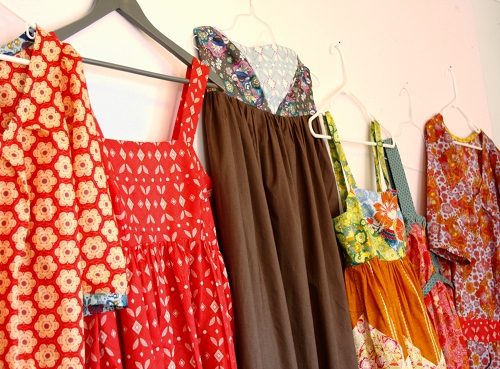
My Voile
While I know that other designers at Westminster will be using this substrate in the future (Kaffe and Valori that I know of so far), I am choosing to call this my voile. Not because I am territorial, but because I kept FedEx in business by shipping back and forth every voile sample overseas that I could and feeling, rubbing, blowing my breath through (its weird but I do this with fabric- its tests how "breathable" it is for me), hanging it up, pondering and ultimately deciding which voile I was going to print my artwork on. Some were just slightly too papery, some slightly too slick, and others definitely too sheer.

Quilting with Voile
I was literally asked why I printed voile over and over again at Quilt Market, and it sort of surprised me. Usually this could be answered without a word but just a feel of the fabrics. Realizing though that I was presenting these goods to mostly quilt shop owners who have had one single substrate in various qualities given to them for a few decades, I answered like this: I love quilting cotton, I really, really do. But I don't necessarily really want to wear it all that much. I very often just think it does not work for a lot of clothing patterns that I want to sew for myself. Nor do I really want to sleep under it and roll around with it against my face as I sleep. There is a certain chunkiness to the standard quilting cotton once washed that just doesn't suit my taste for every project. It was time to start being honest with myself and I had the feeling that I was not the only one who felt this way. Not everyone will agree with me. I am not out to convert anyone, but to offer beautiful options that make me happy. But another thing. For an enormous group of creative, resourceful and brilliant quilters, whether tradition loving or modern, how could an industry which was built upon making art of any and every available scrap of cloth come to rely upon only one variety of fabric from which to create its' art form? I find that the most gorgeous examples of early quilt making are a result of not just the combination of fabrics and patterns but also textures. So to answer the other popular question - Can you quilt with voile? - the answer is OF COURSE! Not only can you quilt with it, but you will be so glad that you did! The softness and livability of this fabric is unparalleled. Should I remind you that I love our standard quilting cotton? I do, I really do. But.
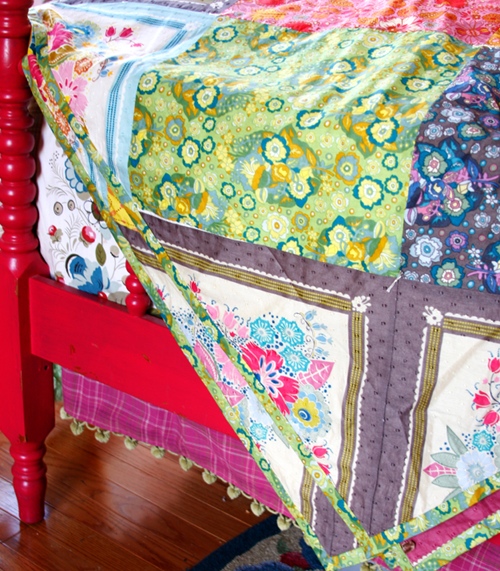
Those of your that live in warmer climates, a quilt from voile doesn't have to be left at the bottom edge of the bed all the time to avoid burning up. Simply making a hand tied, patchwork coverlet with an added layer of muslin or an extremely lightweight batting inside is a gorgeous and supple bedding alternative. Ashley at Film in the Fridge has made some gorgeous quilts from Little Folks that are making me jealous for quilting time. The voiles also present a perfect opportunity to do foundation blocks, such as with a string quilt, because you have that extra layer added into your sewing for stability, but all the seams don't prevent the quilt from moving freely around like it might with heavier fabrics.

(project in my upcoming book, Handmade Beginnings - pre-selling now!)
Texture and Sheerness
I settled on what I felt was the very best option for a fabric that would be used for clothing, quilting, craft, and other home goods. 100% cotton, the texture of this fabric is as soft as it could possibly be without it being slippery. The word butter is used a lot after people feel it for the first time. As most voiles go, I would say that mine are less sheer that what many who know voile, would consider typical. The sheerness factor in my collection is directly related to the color factor. The lighter color the fabric the more sheer the appearance. I wear clothing from the darker printed shades without a lining or camisole unless its a skirt or dress, because you can definitely see light through them. So in many ways the fabric is similar to cotton lawn, but not quite as crisp or papery as most lawns that I am familiar with.

Washing
And because this fabric is 100% cotton, it can be washed just exactly like your other cottons. I daresay the voile seems less affected by the first pre-washing than do the quilting cottons. These are higher thread count fabrics that are very tightly woven so I notice less fraying as well when I wash. I get asked a lot about pre-washing because folks feel for some reason that they will fray more because they are lighter weight- not so. Regarding shrinkage, I experimented by cutting two fat quarters exactly the same size and washed (cold water, gentle) and dried (delicate cycle) only one of them. The difference is shown above. As you can see the color and texture look almost completely unchanged, the fraying minimal, the shrinkage is almost none on the lengthwise, but it did shrink about 3/4" on the width. This is good to keep in mind as you sew.
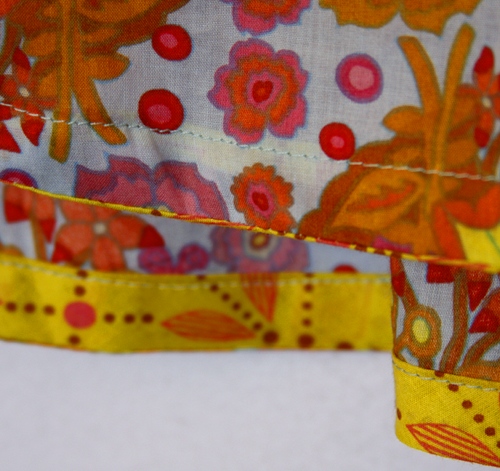
Sewing
As with any higher thread count, tightly woven materials, I would switch to a smaller needle like a 9 or an 11 at the largest. This does of course also depend on what you are sewing the voile to. If you are combining other substrates use your best judgement. A larger needle will not hurt the fabrics but the goal is always to make the smallest hole possible as you sew without breaking tons of needles. Your ironing should typically be on the same setting as with your quilting cottons, but I have found it easier to smooth wash wrinkles (which are minimal to begin with) than with the other cottons.
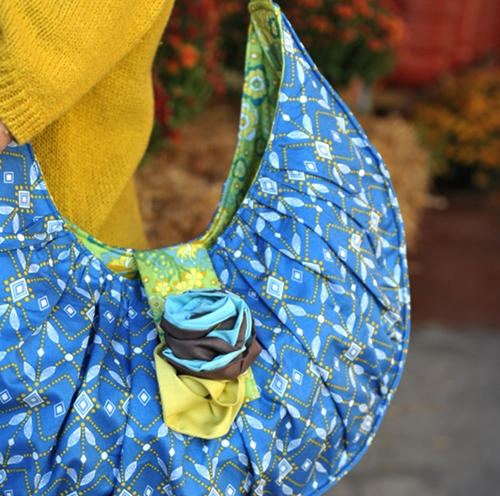
(another new pattern, the Sidewalk Satchel available now!)
Interfacing
You can interface and fuse with this fabric like you would any other cotton. One really helpful tip if you want the voiles to act just exactly like the quilting cottons in weight and body: use an extremely lightweight woven interfacing, fused onto the wrong side of the voile yardage after pre-washing and before beginning your cutting and sewing process. I have done this with pillows and with handbags and I have had excellent results! (My friend Amanda has just made some gorgeous pillows too.)
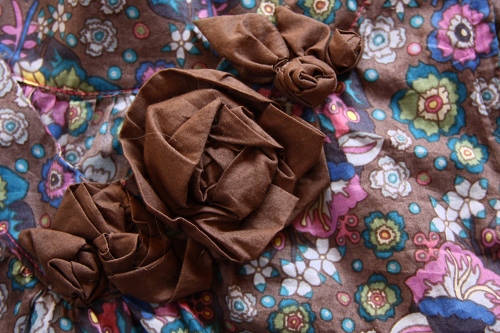
Durability
Another frequent question that I get is with regards to the durability of this fabric. While I haven't been able to sample and test it over a very long period of time, the clothing, quilts that we have made and washed frequently in this family have held up beautifully. Is the life of the fabric as long as the life of the quilting cotton? I don't know. But we don't tend to drag our quilts and clothes around on the cement and over rocks so it depends on what you do with your sewn items always. I would say that if I were going to make an outdoor-use picnic blanket I wouldn't use the voiles, I would go for our heavier substrates. But there are some things that you can do with this fabric that you simply can't (as easily at least) with quilting cotton, such as the tightly tucked, gathered and sculpted flowers above. Happy. Happy.
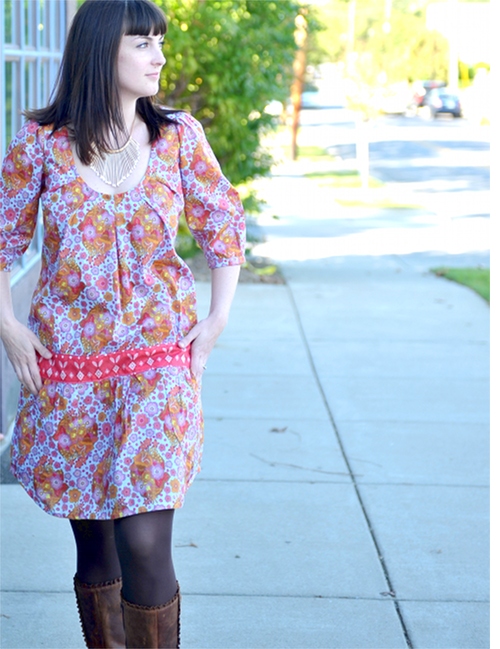
(another new pattern, the Roundabout Dress & Slip available now!)
Cost
I don't like that this fabric costs more. It is, of course, a consideration as I plan collections. But I do LOVE that the goods are 54/55" because this so often means you can buy less length and end up saving money when sewing from a particular pattern. Here is the inch by inch breakdown of the cost of these goods as compared with the quilting cotton:
-One yard of quilting cotton is 36" x 44" and the suggested retail is $9.50 which is 6 cents per square inch of fabric.
-One yard of cotton voile is 36" x 55" and the suggested retail is $15.00 which is 7.5 cents per square inch of fabric.
Looking at it this way just exemplifies that comparing the price per yard alone doesn't factor in how much more fabric you are getting per yard.
I hope this has been helpful. I've been meaning to do this forever, but have also benefited by having my own sewn voiles around the house for awhile to be able to offer you the best insight that I can. If you have further questions or comments, please feel free to leave them here or over at the Little Folks Flickr group.
Have a great weekend! xoox, Anna
Voile
Voile is most always defined as a sheer woven material, usually cotton, and taken from the French word for veil. (I also find that while the pronunciation varies between VO-yul and vwal, that this has most to do with whether you choose to say it in French or in English. Most people, including me, say toile in French so I tend to do the same with voile, not important, just the kind of thing I lose sleep over. Amen.)

My Voile
While I know that other designers at Westminster will be using this substrate in the future (Kaffe and Valori that I know of so far), I am choosing to call this my voile. Not because I am territorial, but because I kept FedEx in business by shipping back and forth every voile sample overseas that I could and feeling, rubbing, blowing my breath through (its weird but I do this with fabric- its tests how "breathable" it is for me), hanging it up, pondering and ultimately deciding which voile I was going to print my artwork on. Some were just slightly too papery, some slightly too slick, and others definitely too sheer.

Quilting with Voile
I was literally asked why I printed voile over and over again at Quilt Market, and it sort of surprised me. Usually this could be answered without a word but just a feel of the fabrics. Realizing though that I was presenting these goods to mostly quilt shop owners who have had one single substrate in various qualities given to them for a few decades, I answered like this: I love quilting cotton, I really, really do. But I don't necessarily really want to wear it all that much. I very often just think it does not work for a lot of clothing patterns that I want to sew for myself. Nor do I really want to sleep under it and roll around with it against my face as I sleep. There is a certain chunkiness to the standard quilting cotton once washed that just doesn't suit my taste for every project. It was time to start being honest with myself and I had the feeling that I was not the only one who felt this way. Not everyone will agree with me. I am not out to convert anyone, but to offer beautiful options that make me happy. But another thing. For an enormous group of creative, resourceful and brilliant quilters, whether tradition loving or modern, how could an industry which was built upon making art of any and every available scrap of cloth come to rely upon only one variety of fabric from which to create its' art form? I find that the most gorgeous examples of early quilt making are a result of not just the combination of fabrics and patterns but also textures. So to answer the other popular question - Can you quilt with voile? - the answer is OF COURSE! Not only can you quilt with it, but you will be so glad that you did! The softness and livability of this fabric is unparalleled. Should I remind you that I love our standard quilting cotton? I do, I really do. But.

Those of your that live in warmer climates, a quilt from voile doesn't have to be left at the bottom edge of the bed all the time to avoid burning up. Simply making a hand tied, patchwork coverlet with an added layer of muslin or an extremely lightweight batting inside is a gorgeous and supple bedding alternative. Ashley at Film in the Fridge has made some gorgeous quilts from Little Folks that are making me jealous for quilting time. The voiles also present a perfect opportunity to do foundation blocks, such as with a string quilt, because you have that extra layer added into your sewing for stability, but all the seams don't prevent the quilt from moving freely around like it might with heavier fabrics.

(project in my upcoming book, Handmade Beginnings - pre-selling now!)
Texture and Sheerness
I settled on what I felt was the very best option for a fabric that would be used for clothing, quilting, craft, and other home goods. 100% cotton, the texture of this fabric is as soft as it could possibly be without it being slippery. The word butter is used a lot after people feel it for the first time. As most voiles go, I would say that mine are less sheer that what many who know voile, would consider typical. The sheerness factor in my collection is directly related to the color factor. The lighter color the fabric the more sheer the appearance. I wear clothing from the darker printed shades without a lining or camisole unless its a skirt or dress, because you can definitely see light through them. So in many ways the fabric is similar to cotton lawn, but not quite as crisp or papery as most lawns that I am familiar with.

Washing
And because this fabric is 100% cotton, it can be washed just exactly like your other cottons. I daresay the voile seems less affected by the first pre-washing than do the quilting cottons. These are higher thread count fabrics that are very tightly woven so I notice less fraying as well when I wash. I get asked a lot about pre-washing because folks feel for some reason that they will fray more because they are lighter weight- not so. Regarding shrinkage, I experimented by cutting two fat quarters exactly the same size and washed (cold water, gentle) and dried (delicate cycle) only one of them. The difference is shown above. As you can see the color and texture look almost completely unchanged, the fraying minimal, the shrinkage is almost none on the lengthwise, but it did shrink about 3/4" on the width. This is good to keep in mind as you sew.

Sewing
As with any higher thread count, tightly woven materials, I would switch to a smaller needle like a 9 or an 11 at the largest. This does of course also depend on what you are sewing the voile to. If you are combining other substrates use your best judgement. A larger needle will not hurt the fabrics but the goal is always to make the smallest hole possible as you sew without breaking tons of needles. Your ironing should typically be on the same setting as with your quilting cottons, but I have found it easier to smooth wash wrinkles (which are minimal to begin with) than with the other cottons.

(another new pattern, the Sidewalk Satchel available now!)
Interfacing
You can interface and fuse with this fabric like you would any other cotton. One really helpful tip if you want the voiles to act just exactly like the quilting cottons in weight and body: use an extremely lightweight woven interfacing, fused onto the wrong side of the voile yardage after pre-washing and before beginning your cutting and sewing process. I have done this with pillows and with handbags and I have had excellent results! (My friend Amanda has just made some gorgeous pillows too.)

Durability
Another frequent question that I get is with regards to the durability of this fabric. While I haven't been able to sample and test it over a very long period of time, the clothing, quilts that we have made and washed frequently in this family have held up beautifully. Is the life of the fabric as long as the life of the quilting cotton? I don't know. But we don't tend to drag our quilts and clothes around on the cement and over rocks so it depends on what you do with your sewn items always. I would say that if I were going to make an outdoor-use picnic blanket I wouldn't use the voiles, I would go for our heavier substrates. But there are some things that you can do with this fabric that you simply can't (as easily at least) with quilting cotton, such as the tightly tucked, gathered and sculpted flowers above. Happy. Happy.

(another new pattern, the Roundabout Dress & Slip available now!)
Cost
I don't like that this fabric costs more. It is, of course, a consideration as I plan collections. But I do LOVE that the goods are 54/55" because this so often means you can buy less length and end up saving money when sewing from a particular pattern. Here is the inch by inch breakdown of the cost of these goods as compared with the quilting cotton:
-One yard of quilting cotton is 36" x 44" and the suggested retail is $9.50 which is 6 cents per square inch of fabric.
-One yard of cotton voile is 36" x 55" and the suggested retail is $15.00 which is 7.5 cents per square inch of fabric.
Looking at it this way just exemplifies that comparing the price per yard alone doesn't factor in how much more fabric you are getting per yard.
I hope this has been helpful. I've been meaning to do this forever, but have also benefited by having my own sewn voiles around the house for awhile to be able to offer you the best insight that I can. If you have further questions or comments, please feel free to leave them here or over at the Little Folks Flickr group.
Have a great weekend! xoox, Anna



Comments